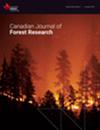三年期改良措施对生长季节沿海盐碱地条件的影响
IF 1.7
3区 农林科学
Q2 FORESTRY
引用次数: 0
摘要
海水入侵和沿海地区地下水位的波动导致土壤盐度和 pH 值的季节性变化,极大地限制了沿海防护林的发展。在一项为期三年的实地研究中,评估了五种土壤改良措施对沿海地区土壤条件的影响。与不添加任何添加剂的对照组(CK)相比,改良剂包括生物炭、生物炭与丛枝菌根真菌(AMF)、秸秆与 AMF、单独秸秆和单独 AMF。结果表明,秸秆、生物炭和 AMF 的组合可降低各层和各季的土壤 pH 值,电导率主要在春季降低。夏季,在 0-20 厘米深的土壤中,由于这些混合物的作用,微生物生物量碳显著增加。此外,在春季,单用 AMF 和含有 AMF 的生物炭显著提高了 0-40 厘米土层的酶活性,而在秋季,单用 AMF 显著提高了同一土层的养分可用性。线性回归分析表明,导电率、微生物生物量碳、酶活性和养分可用性与 pH 值呈负相关。生物炭-AMF 混合物是最有效的土壤改良剂,这表明将其与季节性管理结合使用,可以优化土壤健康,促进沿海地区的造林。本文章由计算机程序翻译,如有差异,请以英文原文为准。
Effect of three-year amendment measures on coastal saline-alkali soil conditions during the growing season
Seawater intrusion and fluctuations in the water table in coastal areas lead to seasonal variations in soil salinity and pH, which greatly limit the development of coastal protection forests. In a three-year field study, the impact of five soil amendment measures were evaluated on soil conditions in coastal areas. Amendments included biochar, biochar with arbuscular mycorrhizal fungi (AMF), straw with AMF, straw alone, and AMF alone, compared to a control (CK) with no additive. Results indicated that combinations of straw, biochar, and AMF reduced soil pH across various layers and seasons, with electrical conductivity mainly decreasing in spring. During the summer, at the 0-20 cm soil depth, microbial biomass carbon notably increased due to these mixtures. Additionally, AMF alone and biochar with AMF significantly improved enzyme activities in the 0-40 cm layer in spring, while in fall, AMF alone notably increased nutrient availability in the same layer. Linear regression analysis revealed a negative correlation between electrical conductivity, microbial biomass carbon, enzyme activity, and nutrient availability with pH. The biochar–AMF mixture emerged as the most effective soil amendment, suggesting that using it in conjunction with seasonal management could optimize soil health and promote silviculture in coastal regions.
求助全文
通过发布文献求助,成功后即可免费获取论文全文。
去求助
来源期刊
CiteScore
4.20
自引率
9.10%
发文量
109
审稿时长
3 months
期刊介绍:
Published since 1971, the Canadian Journal of Forest Research is a monthly journal that features articles, reviews, notes and concept papers on a broad spectrum of forest sciences, including biometrics, conservation, disturbances, ecology, economics, entomology, genetics, hydrology, management, nutrient cycling, pathology, physiology, remote sensing, silviculture, social sciences, soils, stand dynamics, and wood science, all in relation to the understanding or management of ecosystem services. It also publishes special issues dedicated to a topic of current interest.

 求助内容:
求助内容: 应助结果提醒方式:
应助结果提醒方式:


